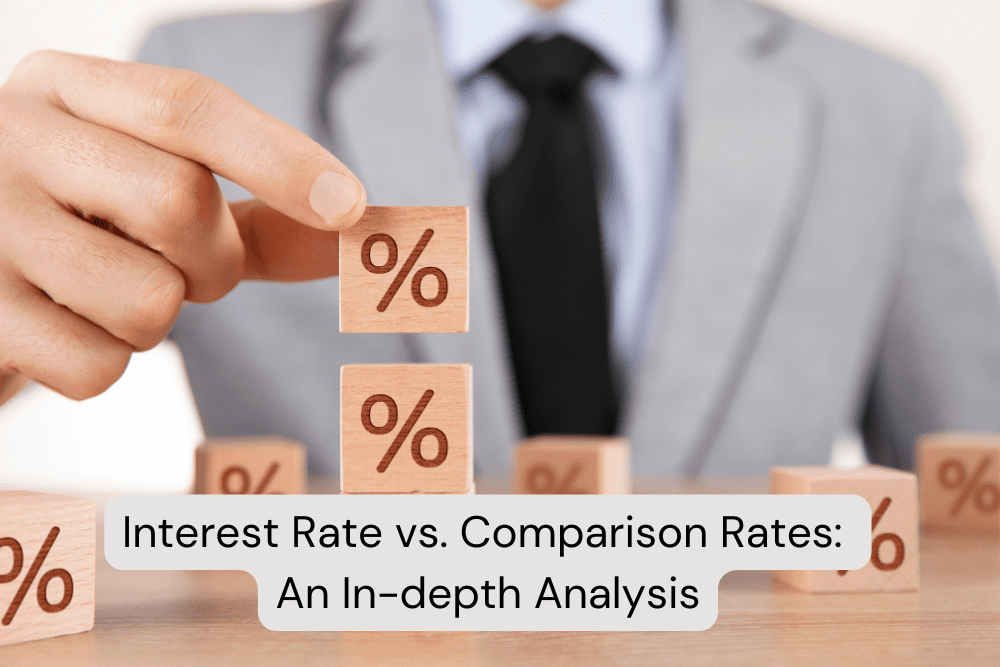When it comes to obtaining a home loan in Australia, understanding the significance of interest rates vs. comparison rates is crucial. Interest rates form the backbone of any loan, dictating the cost of borrowing and the amount of money repaid to the lender over time. On the other hand, comparison rates offer borrowers a clearer picture of the true cost of a loan by considering additional fees and charges associated with the loan. Together, these rates play a pivotal role in helping borrowers make informed decisions about their home loans.
Understanding Interest Rates
A. Definition and Mechanism of Interest Rates
Interest rates refer to the percentage lenders charge on the principal amount borrowed. They serve as compensation for the risk undertaken by lenders and as an incentive for providing funds to borrowers. When borrowers take out a home loan, they commit to repaying the borrowed amount along with interest over the loan’s tenure. The mechanism of interest rates is essential to comprehend, as it directly impacts the total amount paid by borrowers and the overall cost of the loan.
B. Distinction Between Fixed and Variable Interest Rates
In Australia, borrowers have the option to choose between fixed and variable interest rates for their home loans. Fixed interest rates remain constant throughout a predetermined period, providing stability and predictability in monthly repayments. On the other hand, variable interest rates fluctuate with changes in the market’s interest rates, offering potential benefits during periods of economic stability. Understanding the nuances of these rate types is essential for borrowers to select the one that aligns best with their financial goals and risk tolerance.
Read More > Latest Eligibility Criteria Here.
C. Factors Influencing Interest Rates in Australia
Interest rates in Australia are influenced by an array of factors, both domestic and global in nature. The Reserve Bank of Australia (RBA) plays a pivotal role in setting the official cash rate, which significantly impacts the interest rates offered by financial institutions across the country. Additionally, economic indicators such as inflation, unemployment rates, and the overall health of the economy also influence interest rates. Exploring these factors in detail can help borrowers anticipate potential changes in interest rates and make well-informed decisions regarding their home loans.
Understanding Comparison Rates
A. Definition and Significance of Comparison Rates
Comparison rates provide borrowers with a holistic view of the actual cost of a home loan by factoring in not just the interest rate but also additional fees and charges associated with the loan. It helps borrowers compare different loan offers on an apples-to-apples basis, ensuring they are well-informed about the overall expenses of borrowing from various lenders. The significance of comparison rates lies in their ability to prevent borrowers from falling into the trap of choosing a loan with an attractive low-interest rate but higher hidden costs.
B. Calculation of Comparison Rates
The calculation of comparison rates involves a standardized formula that includes the nominal interest rate, the loan term, and the majority of upfront and ongoing fees. This formula enables borrowers to make an accurate comparison between different loan options, even when the loans have different fee structures or repayment terms. By understanding the mathematical process behind comparison rates, borrowers can confidently evaluate the best loan offers available to them.
C. Factors Influencing Comparison Rates
Several factors contribute to the variation in comparison rates among different home loans. The most significant factor is the nominal interest rate, but other elements such as application fees, ongoing fees, redraw fees, and the presence of offset accounts can also impact the comparison rate. Additionally, the loan term and the frequency of compounding interest can influence the final comparison rate figure. By being aware of these factors, borrowers can better assess the true value of a loan and select the one that aligns with their financial goals.
Differences Between Interest Rates and Comparison Rates
A. Distinct Meanings and Purposes
Interest rates represent the cost of borrowing money from a lender and directly impact the monthly repayments of a loan. They focus solely on the percentage charged on the borrowed principal. On the other hand, comparison rates encompass the interest rate along with associated fees, providing a more comprehensive outlook on the actual cost of the loan. While interest rates are essential for assessing the monthly affordability of a loan, comparison rates are crucial for evaluating the long-term affordability and suitability of different loan options.
B. When to Use Interest Rates and Comparison Rates
Interest rates are valuable when borrowers want to calculate the exact amount they will pay each month. It allows them to budget and assess whether the monthly repayments are affordable. However, when borrowers are comparing various loan offers from different lenders, comparison rates become indispensable. It helps borrowers understand the true cost of a loan and enables them to compare multiple offers on equal grounds, safeguarding against hidden charges.
C. Understanding the Disparity Between the Two Rates
The disparity between interest and comparison rates is evident in how the latter accounts for additional costs beyond the nominal interest rate. This difference can be substantial, especially in loans with complex fee structures or bundled services. Understanding this disparity empowers borrowers to make well-informed decisions, avoiding any surprises in the future and securing a loan that meets their financial needs and preferences.
Importance of Comparison Rates for Borrowers
A. Empowering Borrowers to Make Informed Decisions
Comparison rates are pivotal in empowering borrowers to make well-informed decisions when selecting a home loan. By providing a comprehensive view of the true cost of borrowing, comparison rates eliminate confusion and equip borrowers with the necessary information to evaluate various loan options effectively. With this clarity, borrowers can confidently navigate the sea of lenders and loan offers, ensuring they choose a loan that aligns with their financial goals and budget.
B. Identifying the True Cost of a Loan
One of the primary advantages of comparison rates is their ability to unveil the hidden costs associated with home loans. While interest rates may seem enticingly low, additional fees and charges can substantially impact the overall cost of borrowing. Comparison rates give borrowers a clearer understanding of the total expense they will incur over the loan term, including establishment fees, ongoing account fees, and discharge fees, among others. Armed with this knowledge, borrowers can avoid costly surprises and make informed financial decisions.
C. Factors to Consider When Comparing Rates
When comparing loan offers using comparison rates, borrowers should consider various factors. Loan terms, for instance, can significantly impact the total repayment amount. A longer loan term may come with lower monthly repayments, but it might also result in higher overall interest payments. Additionally, borrowers must assess their individual financial situation, including their income stability and future financial plans, to determine the most suitable loan option. Careful consideration of these factors ensures borrowers choose a loan that not only fits their immediate needs but also aligns with their long-term financial objectives.
Limitations of Comparison Rates
A. Situations Where Comparison Rates May Not Be Accurate
While comparison rates are a valuable tool, there are instances where they may not provide a complete picture of a loan’s true cost. For example, some lenders may offer promotional interest rates for a limited period, which can significantly differ from the comparison rate. Additionally, unique loan features such as offset accounts or redraw facilities may not be fully captured in the comparison rate calculation, leading to potential discrepancies. Borrowers should be aware of these situations and seek clarification from lenders to understand the full scope of the loan offer.
B. Understanding the Limitations in Practical Applications
While comparison rates serve as a useful benchmark, they should not be the sole determinant for choosing a home loan. Each borrower’s financial situation is unique, and individual needs and preferences may vary. Therefore, while comparison rates offer valuable insights, borrowers should also consider other factors like customer service, lender reputation, and loan flexibility. Conducting thorough research and seeking professional advice from mortgage brokers can help borrowers gain a more comprehensive understanding of their options.
C. Additional Factors to Consider While Evaluating Loan Options
Apart from comparison rates, borrowers should also consider other factors, such as exit fees and break costs associated with early loan repayment. Some loans may have strict penalties for paying off the loan ahead of the agreed-upon term. Additionally, borrowers must evaluate the loan’s eligibility criteria, as some loans may have stringent requirements that may not suit every borrower. By examining these factors alongside the comparison rates, borrowers can make a well-rounded assessment of various loan offers.
Impact on Borrowing Decisions
A. How Interest Rates Affect Borrowing Decisions
Interest rates wield a significant influence on borrowing decisions, as they directly impact the affordability of a home loan. When interest rates are low, borrowers find it more enticing to secure a loan since the lower rates translate into reduced monthly repayments. Low-interest rates can also enable borrowers to qualify for higher loan amounts. On the other hand, high-interest rates can deter potential borrowers, leading to higher monthly repayments, potentially stretching the budget beyond comfort. The fluctuation of interest rates in the market can prompt borrowers to time their loan application strategically to secure the most favorable rates.
B. How Comparison Rates Influence Borrowing Decisions
Comparison rates are instrumental in shaping borrowing decisions by providing borrowers with a comprehensive understanding of the true cost of a loan. When comparing different loan options, borrowers can use comparison rates as a guide to assess the overall value of each offer. Loans with low-interest rates but high additional fees may have higher comparison rates, making them less attractive in the long run. By focusing on comparison rates, borrowers can avoid being swayed solely by low-interest rates and make a more informed choice that considers both the interest charged and associated fees.
C. Factors to Prioritize When Choosing a Home Loan
When navigating the vast array of home loan options, borrowers must prioritize certain factors to find the most suitable loan for their individual needs. While interest rates and comparison rates are essential considerations, other factors demand attention too. Loan features, such as the ability to make extra repayments, the presence of an offset account, and flexibility in redraw facilities, can significantly impact the loan’s overall value. Moreover, borrowers should assess the loan term, ensuring it aligns with their financial goals and repayment capabilities. Evaluating these factors in combination enables borrowers to make confident and informed decisions when selecting a home loan.
Best Practices for Borrowers
A. How to Effectively Use Interest Rates and Comparison Rates
Effectively using interest rates and comparison rates involves a comprehensive evaluation of the entire loan offer. Borrowers should weigh the interest rates against other fees, such as establishment and ongoing charges, to gain a clear picture of the loan’s true cost. While low-interest rates can be appealing, borrowers must not overlook the significance of comparison rates in identifying any hidden costs associated with the loan. Conducting thorough research and using online loan comparison tools can aid borrowers in making a well-balanced assessment and selecting the most suitable loan for their financial circumstances.
B. Tips for Negotiating Better Rates with Lenders
Negotiating with lenders can prove beneficial in securing favorable interest rates and loan terms. Being well-informed about current market rates and the rates offered by competitors allows borrowers to negotiate from a position of strength. Additionally, demonstrating strong creditworthiness and a stable financial position can enhance the borrower’s bargaining power. Engaging with multiple lenders and being open to exploring different loan options can lead to finding more competitive rates.
C. Understanding the Relationship Between Rates and Loan Terms
The relationship between interest rates and loan terms is essential to grasp for borrowers. While longer loan terms may result in lower monthly repayments, they also mean higher overall interest payments over time. Shorter loan terms, while requiring higher monthly repayments, lead to less interest paid in total. Understanding this connection allows borrowers to strike a balance between affordability and interest savings. Selecting an appropriate loan term that aligns with financial goals is key to managing the loan efficiently.

Conclusion
In conclusion, understanding the nuances of interest rates and comparison rates is paramount for any borrower seeking a home loan in Australia. These two essential metrics play distinctive yet interconnected roles in shaping borrowing decisions and determining the true cost of a loan.
Interest rates, as the backbone of any loan, wield considerable influence over borrowers’ financial choices. When interest rates are low, borrowers can seize the opportunity to secure a loan with reduced monthly repayments and potentially qualify for higher loan amounts. Conversely, high-interest rates may lead borrowers to exercise caution, as they can strain budgets and impact long-term affordability. Keeping a close eye on market fluctuations empowers borrowers to time their loan applications strategically, maximizing the benefits of low-interest rates.
Frequently Asked Questions (FAQs)
Why is the comparison rate lower than the interest rate?
The comparison rate is lower because it factors in additional fees and charges associated with the loan, providing a more accurate representation of the loan’s true cost. In contrast, the interest rate only reflects the percentage charged on the borrowed amount.
How do you calculate the comparison interest rate?
The comparison rate is calculated using a standardized formula that includes the nominal interest rate, loan term, and most upfront and ongoing fees. This formula allows borrowers to compare different loan offers on equal grounds.
Is the comparison rate the effective rate?
Yes, the comparison rate is considered the effective rate as it includes both the nominal interest rate and additional fees, providing borrowers with a more comprehensive view of the overall cost of the loan.
What is the difference between fixed and interest rates?
The interest rate represents the percentage charged on the principal amount borrowed, while a fixed interest rate remains constant over a predetermined period, offering borrowers stability in monthly repayments.
Is a low comparison rate better?
Yes, a low comparison rate is generally better as it indicates lower additional fees and charges, making the overall cost of the loan more affordable for borrowers.
Why is the comparison rate so high?
The comparison rate can be high due to the inclusion of various additional fees and charges associated with the loan, such as application fees, ongoing fees, and redraw fees.
Why is it bad if interest rates are high?
High-interest rates can lead to higher monthly repayments, making it more challenging for borrowers to afford loans. It can also impact overall borrowing costs, potentially discouraging borrowing and spending in the economy.
Who benefits from low-interest rates?
Borrowers benefit from low-interest rates as it reduces their borrowing costs, resulting in more affordable monthly repayments. It can also stimulate spending and economic growth by encouraging investment and consumption.
Will higher interest rates reduce inflation?
Yes, higher interest rates can reduce inflation by curbing borrowing and spending, which in turn can lead to decreased demand and lower price levels in the economy. Central banks often use higher interest rates as a tool to control inflation.





